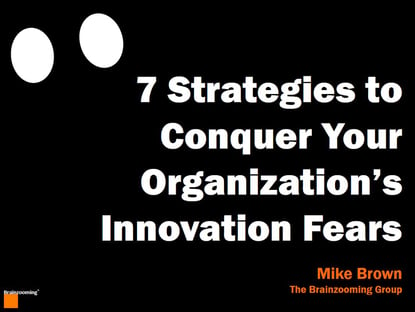Last fall, Emma and I saw Beth Comstock, the former vice chair of General Electric and head of its GE Business Innovations unit, keynote at the Inbound conference. Ever since, I’ve been carrying around five quotes of hers pulled from the talk. While the conference featured stronger keynotes, these innovation strategy-focused quotes and action items from Beth Comstock resonated with me.

Quote 1. "Strategy is a story, well-told."
One Thought: Strategy shouldn’t be complex, jargon-filled, and nonsensical to anyone beyond the top executives. Employees can better implement strategies when they connect in a meaningful way. Stories are a powerful, age-old way to share information, highlight important truths, and teach lessons that move people to understanding and action. Sounds exactly like what you want organizational strategies to do, doesn’t it?
Take Action: Sources differ on what elements a story must include. Yet, to turn your strategy into a story, consider focusing on:
- The theme that best describes the strategy’s intent
- Which people are integral to bringing the strategy to life along with who will enjoy its benefits
- A sense of the steps and movement you will use to implement the strategy
- Where the strategy will play out
- A hint of the emotional impact that will accompany its success
Incorporating these five elements will provide a strong start toward making it easier to communicate and act.
Quote 2. "To open communication with someone, start by asking, 'What is something you need to tell me that I don't want to hear?'"
One Thought: No matter how accessible executives try to be, employees talk behind their backs. Part of that chatter is about what to never discuss with them. Beth Comstock’s suggestion is intriguing. Unless the people on the other side of the table feel they are on equal footing, though, it will likely take several reiterations for team members to trust this opening.
Take Action: Want to make strides toward opening the way for your team to deliver bad or challenging news? Let them know in a non-threatening setting that you’re going to introduce this question (or something similar) into interactions. Introducing this new communication tactic in a group setting where no one is expected to immediately respond is a positive way to set the stage. It lessens the concern and apprehension that this question could trigger when it’s a surprise without any context.
Quote 3. "When you hear someone tell you, 'No,' process it as them saying, 'Not yet.' At a minimum, try to sell your ideas three times, but do it a dozen times if the idea warrants it."
One Thought: Never give up quickly on what’s valuable and important. Perhaps the audience isn’t ready for it now. Maybe you aren’t clearly communicating your idea. The no could contain a valid challenge or contrary view that you need to step back, consider, and incorporate. A negative response might also suggest a new possibility that you have yet to consider.
Take Action: Identify the people you expect will challenge your idea, and the areas where negative responses are likely to arise. Invest time in developing a communications strategy that supports you in selling in your idea. What is your most compelling message? How can you appropriately and honestly adapt it for specific audiences? Who will you approach to help you practice communicating your idea (because any no message will not be a directive to stop)? Finally, every time you pitch your idea, experiment with improving your messaging, to learn what could work to sell it effectively the next time.
Quote 4. "Failure is the F-word of business. If failure isn't an option, then neither is success."
One Thought: It’s easy for organizations to say they expect failure. The official message may be that failure is necessary for a successful innovation strategy. Giving that message credibility with employees, so that they will take risks, requires more than talk. It demands clear, consistent, and long-term demonstrations that people who fail (and learn) as they pursue important innovations will not be punished.
Take Action: At your next management meeting, take a few moments to list notable failures from the last twelve-to-eighteen months. Along with each failure, identify the main person associated with it. Note, as objectively as possible, changes in the organization’s perspective on each of the people experiencing failures. How many are viewed more favorably now than before? How many are viewed with greater skepticism? If you aren’t celebrating and advancing the people taking risks and failing, what management actions in the next year will change that and bring new life to your innovation strategy?
Quote 5. "What's a risk you will give yourself permission to take?"
One Thought: If you’re cheering on others in the organization to embrace risk, make sure you are also taking visible risks.
Take Action: List the risks you took over the last year that made you uncomfortable. How many are there? How uncomfortable did each of them really make you? What are you going to do this year to increase your risk-taking behaviors?
Five Quotes and Do This!
If you are trying to innovate more, and more effectively, marry the messages and the actions that tell the stories and celebrate the successes and failures of those embracing and acting on smart, innovative risks. – Mike Brown
Conquer Fears of Business Innovation!
FREE Download: "7 Strategies to Conquer Your Organization’s Innovation Fears"
 Whether spoken or unspoken, organizations can send strong messages saying, “If it isn’t broken, don’t screw around with it” in a variety of ways. Such messages make it clear that good things do not await those pushing for an innovation strategy involving any significant level of risk.
Whether spoken or unspoken, organizations can send strong messages saying, “If it isn’t broken, don’t screw around with it” in a variety of ways. Such messages make it clear that good things do not await those pushing for an innovation strategy involving any significant level of risk.
This free Brainzooming innovation eBook identifies seven typical business innovation strategy fears. For each fear, we highlight strategy options to mitigate the fears and push forward with innovative strategies. We tackle:
- Whether facts or emotional appeals are ideal to challenge fear of innovation-driven change
- When it is smart to call attention to even bigger fears to motivate progress
- Situations where your best strategy is taking business innovation underground




